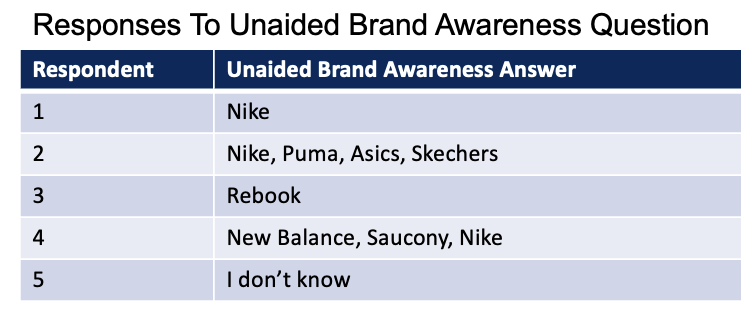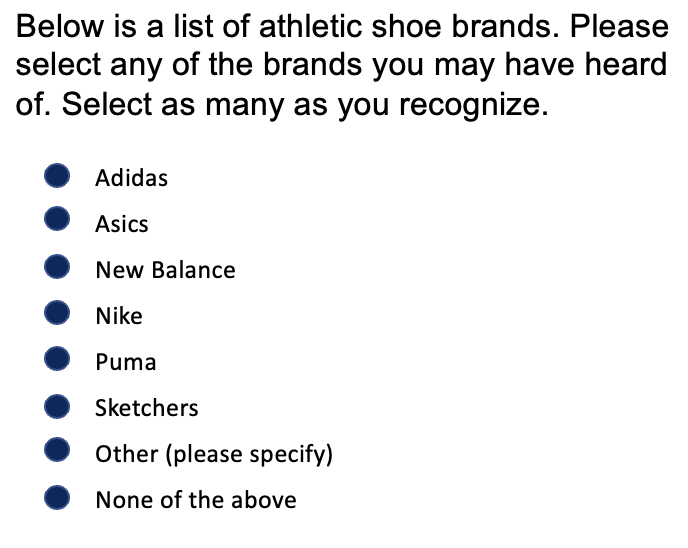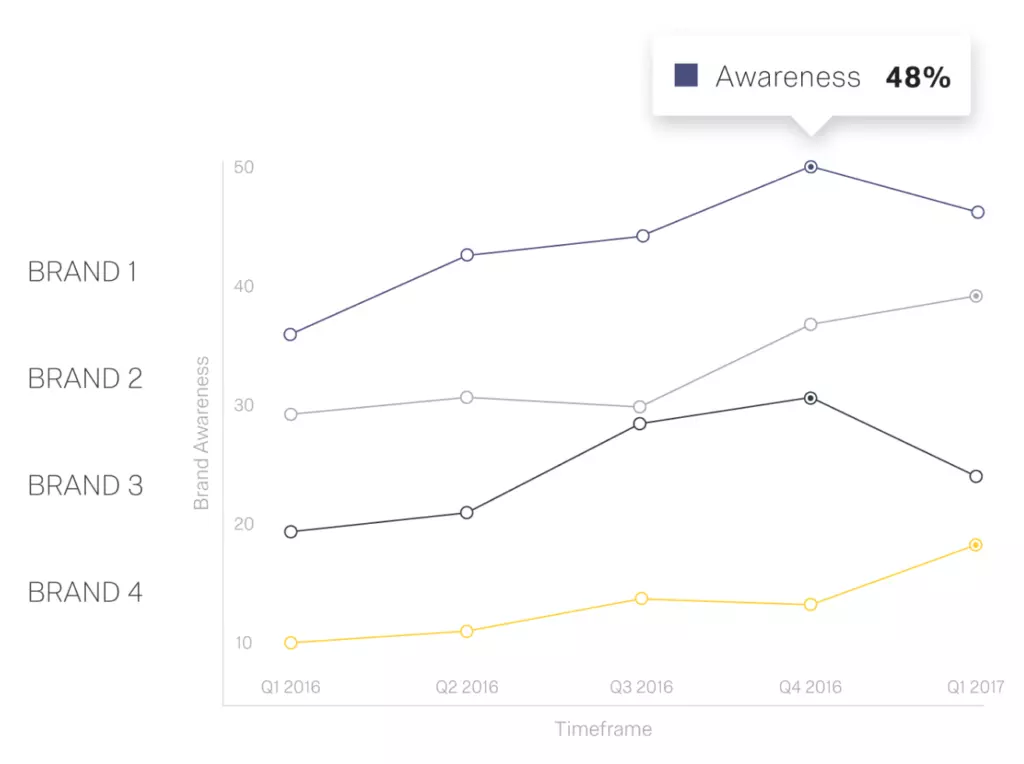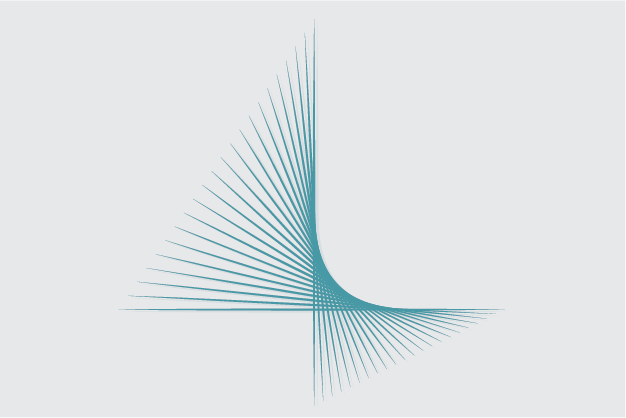Brand awareness directly ties to revenue. Consider a recent study that showed repeated brand advertising results in 23% revenue growth. This is because the more people know a brand, the more they are likely to buy it. Additionally, brand awareness also has positive impacts on customer lifetime values (LTV) and customer acquisition costs (CAC).
It’s a powerful tool companies have in their arsenal, if they are willing to invest in growing their brand in the first place.
This is why organizations focus on measuring brand awareness. It provides an objective measure of how well branding efforts are working. And, it also provides a valuable “canary in the coal mine” to tell you when to step up or evolve your brand strategies.
What Is Brand Awareness
Brand awareness tells you how well known your brand is among relevant customer groups. It’s an objective way to evaluate how strong your brand and competitor brands are within a specific product or service category.
Companies engage in a wide variety of marketing tactics to build overall brand awareness, including:
– Online display ads
– Outdoor advertising
– Print advertising
– Conference and event sponsorships
– Email marketing
– Social media advertising
In essence, there are a lot of ways to potentially build brand awareness. But, an organization must spend the time to actually measure awareness to determine if their tactics are effective.
Why Measure Brand Awareness
Organizations should measure brand awareness to benchmark their market position, evaluate the efficacy of their marketing activities, and identify emerging players in their category.
Let’s look at these each a bit further.
1. Gauge Your Market Position
Business guru Peter Drucker once said, “What gets measured gets managed.” Business that claim to care about brand awareness must actually spend time measuring it. It tells you exactly what your market position is and your opportunity for improvement. Relatedly, it gives you a read on how competitors rank as well.
2. Measure Marketing Efficacy
As we mentioned above, marketing is often geared toward building a brand’s awareness. If you plan to make major marketing investments, you should make a point of knowing early on if they are working. By measuring awareness before and after campaigns, you measure exactly how awareness changes over time. If numbers trend well, keep doing what you’re doing. If you see no improvement, or decreases, try a new approach.
3. Identify Emerging Competitors
New competitors pop up all the time. So much so that it’s hard to keep track of all of them. However, by actively measuring the awareness of not just your brand but competitor brands, you have a proactive approach to identifying these upstarts.
4. Evaluate If You Have A Competitive Differentiator
With some studies pointing to as much as 95% of purchase decisions being subconscious, creating a foundation for trust is key. Building brand awareness, gives you a leg up on your competition. However, if you don’t measure it, you’ll never know how you really compare.
What Brand Awareness Metrics Matter
When performing brand awareness research studies, you should always measure two types of awareness: aided and unaided awareness.
Why Unaided Brand Awareness Matters
Unaided awareness is a way to measure top-of-mind awareness. In essence, it lets you gauge how well any given customer can remember your name with zero prompts.
Measuring unaided brand awareness is a straightforward process. People are asked to name all brands they can think of in a particular category. They can name as many or as few that come to mind.
For instance, let’s say you sell sneakers. To measure unaided awareness, you ask people to name all of the sneaker brands that come to mind. Respondents get an open box to enter whatever comes to mind.

If we did this in a real study, we’d see responses like what what is in the table to the left. In this example, some respondents name one brand. In others, they name multiple brands. And, we see that they can also enter some variation of “I don’t know.”
Once all of the responses are in, we count the number of times each brand is mentioned. We then divide it by the total number of people in our study and multiply by 100. That gives us each brand’s unaided brand awareness.
Why Aided Brand Awareness Matters
In addition to unaided awareness, we almost always ask about aided awareness too. Aided brand awareness tells us how well customers recall the name of a brand. To measure this, respondents look at a list of brand names. They then select all of the brands they recognize.
Let’s continue using our sneaker brand example to see how to measure aided brand awareness. We first develop our list of brands. From here, respondents select all of the brands they recognize.
Once all responses are in, it’s time to tabulate the results. We count the number of times a brand gets selected. We divide this by the number of responses and multiply by 100.

How To Measure Brand Awareness
Now that we know what we are measuring, and why we are measuring it, let’s look at how to measure brand awareness.
1. Build A Survey
Brand awareness studies are conducted via surveys. This means you must first draft your survey questions. You’ll of course include questions to measure unaided and aided brand awareness. However, you can and should include other brand health dimensions. This includes things like brand perceptions, loyalty, and use cases.
2. Program Your Survey
We typically field brand awareness surveys digitally. This means we must take our survey design and then program it into a survey platform. Once programmed, be sure to test it a few times. And, invite a few other people to test it too. This is the last chance you have to evaluate the questions and survey-taking experience.
3. Collect Your Data
You’re now ready to have people take your survey. Be sure to recruit enough individuals so that you can feel confident in your final brand awareness numbers. Our rule of thumb is to recruit enough individuals that we have no more than +8% margin of error. This means that we can be sure our numbers are within plus or minus 8% of the actual population.
4. Tabulate Your Results
Once the data is in, it’s time to tabulate it all together. At this point, you’re determining the brand awareness for you and competitor brands. This is also when you gauge how people responded to your other brand health questions.
5. Look For Trends Within Customer Segments
An optional last step is to see if your results vary by certain customer segment. For instance, you may want to if metrics changes based on a respondent’s gender, age, job title, or other feature.
Who Should Be Included In Your Brand Awareness Study
Who you survey is almost as important as how you survey them. After all, you want to make sure you’re asking about awareness from only those people who would realistically now your brand or competitor brands.
In essence, you want to only include people that have purchased or would likely purchase your product. For instance, if you are a mayonnaise brand, you only want to recruit people who purchased mayonnaise in the past year. Or, if you sell email marketing software, you only want people who have considered or purchased email marketing solutions.
Make Brand Awareness Measurement A Recurring Activity
Once you have a process down for how to measure brand awareness for your specific organization, be sure to make it a recurring activity.
The initial measurement is just that. It’s a point-in-time view of brand awareness today. However, business environments are dynamic. That means brand awareness numbers will change. Over time, you’ll want to keep an eye on how your evolutions in marketing and advertising impact your core awareness. The same is true of competitor activity.
We see this in action with the graph on the right. Committing to quarterly brand awareness measurements lets us track how individual brand activities impact awareness over time.
By committing to regular brand awareness measurement, you will never be left surprised. Rather, you will keep your finger on the pulse of brand and category dynamics.







